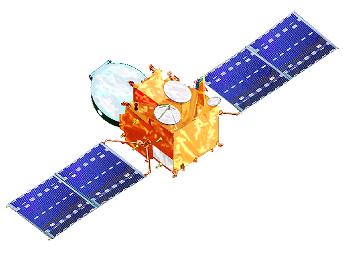An event during which the launch will be broadcast live will take place at the President's House on Thursday morning, and will be integrated into the 60th anniversary celebrations of the State of Israel

The Communication Space Company, operator of Amos satellites, will launch the Amos-3 communication satellite this Thursday from the launch site in the city of Baikonur in Kazakhstan.
Amos-3 is the most advanced and latest version of the communications satellites of the Space Communications Company and Israel in general, so far.
The satellite was designed and built by the aerospace industry for Spacecom, which defined the improved performance required of the satellite, following the technical and commercial success of Amos-1 and Amos-2. The construction of the satellite took about three years, during which about 100 employees of the "Mabat-Hell" factory of the Aerospace Industry took part in the project. It should be noted that Israel belongs to a limited club of 8 countries in the world that design and manufacture operational or commercial satellites.
The launch of the satellite took on a state dimension when it was recently included in the official celebrations of the 60th year, and received the patronage of the country's president, Shimon Peres. Accordingly, the Space Communications Company decided to decorate the satellite canopy at the top of the launch vehicle with the logo of the events of the 60s.
Amos-3 is equipped with four transmission antennas, two of which are mobile and can be adjusted from the ground according to customer needs. Thus, in addition to television, radio and data transmission services on the fixed beams to the East Coast of the United States, the Middle East and Europe, Amos-3 can provide services through the mobile antennas, to any point in the Middle East, Europe, Africa and other regions of the American continent.
Amos-3 will be launched to the same point in space where Amos-1 and Amos-2 are located and it is a point that is 4 degrees west. It will be located at an altitude of 36,000 km above the equator, in a special orbit called geostationary orbit. The launch will be carried out using a powerful zenith launcher which will raise the satellite directly to the final service altitude and thereby allow an increased lifespan for Amos-3.
In the coming months, Amos-3 will replace the Amos-1 satellite, which will end its life after 12 years of successful operation. Amos-2, launched in December 2003, is expected to have another eight years of service in parallel with its new neighbor Amos-3.
Prior to its launch into space, over 85% of Amos-3's service capacity was purchased ahead of time, and the company estimates that the capacity usage agreements in full will be completed soon.
The cost of the Amos-3 satellite is about 170 million dollars.
Additional data
• Its weight is 1.3 tons (several hundred kilograms less than its two predecessors);
• Contains 420 kg of fuel (compared to 760 kg in Amos-2);
• The satellite communication equipment weighs 250 kg (compared to 160 kg in Amos-2);
• Life span - 18 years (compared to 12 years in Amos-2);
The preparations for the launch
The Amos-3 satellite was moved to the Baikonur launch site on March 18, 2008 and preparations began for its integration into the launcher, which included refueling the satellite and final functional and mechanical tests.
The launcher was transported by a special freight train, so the launch was horizontal. Upon reaching that time, the launch was placed in a vertical position and the final preparations for the launch began.
The countdown will start five hours before the launch, and in the last hour and a half the launcher will be powered up.
the launcher
The satellite will be launched by the three-stage Zenit launcher (called Zenit-3SLB). This launcher was adapted, among other things, for flights to Mars.
The three-stage launcher stands 59 meters tall and weighs over 460 tons at launch.
Thanks to the relationship between the high lifting capacity of the launcher and the relatively low weight of Amos-3, it is possible to bring the satellite directly to its final service altitude (36,000 km). The large amount of fuel saved in such a situation translates into an increase of about 50% in the satellite's lifespan.
The beginning of his life on Amos-3
Immediately after launch, the satellite will perform several initial operations:
- 6 minutes after the launch - will open its antennas that enable the ability to receive and transmit.
- 20 minutes after injection - will orient itself in space in an accurate way towards the Earth.
- 40 minutes after the injection - the retirement of the solar panels that provide him with energy from the sun.
Seven hours and 19 minutes after launch, the satellite will be released from the last of three stages, and will enter its initial orbit. So in fact the satellite will begin its independent life in space.
After the tests are finished, the satellite's communication systems will be activated at full power, and an orderly transfer of the customers whose transmissions are transmitted through Amos-1 to Amos-3 will begin, as well as the reception of the new subscribers.

3 תגובות
Want broadcasts in high definition!!!
On the NASA website, you have NASA TV, which transmits live broadcasts of launches, operations, works, etc.
A question for my father, the editor of the site, please, where can I watch the launch live
On which website on the internet is this not a childish question please Noam if you can help Happy Holidays